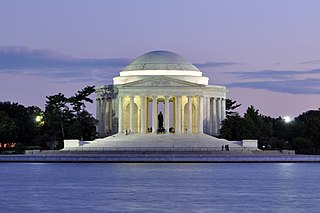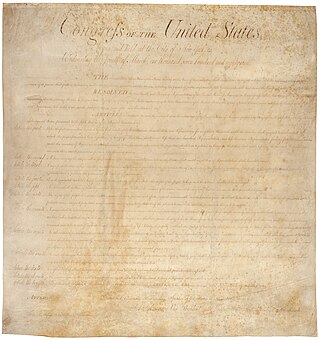Related Research Articles

Thomas Jefferson was an American statesman, diplomat, lawyer, architect, philosopher, and Founding Father who served as the third president of the United States from 1801 to 1809. Among the Committee of Five charged by the Second Continental Congress with drafting the Declaration of Independence, Jefferson was the document's primary author. Following the American Revolutionary War and prior to becoming president in 1801, Jefferson was the first U.S. secretary of state under George Washington and then the nation's second vice president under John Adams.

The First Amendment to the United States Constitution prevents the government from making laws that regulate an establishment of religion, or that prohibit the free exercise of religion, or abridge the freedom of speech, the freedom of the press, the freedom of assembly, or the right to petition the government for redress of grievances. It was adopted on December 15, 1791, as one of the ten amendments that constitute the Bill of Rights.
Wallace v. Jaffree, 472 U.S. 38 (1985), was a United States Supreme Court case deciding on the issue of silent school prayer.
Abington School District v. Schempp, 374 U.S. 203 (1963), was a United States Supreme Court case in which the Court decided 8–1 in favor of the respondent, Edward Schempp, on behalf of his son Ellery Schempp, and declared that school-sponsored Bible reading and the recitation of the Lord's Prayer in public schools in the United States was unconstitutional.

The Jefferson Memorial is a presidential memorial built in Washington, D.C., between 1939 and 1943 in honor of Thomas Jefferson, the principal author of the United States Declaration of Independence, a central intellectual force behind the American Revolution, founder of the Democratic-Republican Party, and the nation's third president.
"Separation of church and state" is a metaphor paraphrased from Thomas Jefferson and used by others in discussions regarding the Establishment Clause and Free Exercise Clause of the First Amendment to the United States Constitution which reads: "Congress shall make no law respecting an establishment of religion, or prohibiting the free exercise thereof..."
Everson v. Board of Education, 330 U.S. 1 (1947), was a landmark decision of the United States Supreme Court that applied the Establishment Clause of the First Amendment to state law. Prior to this decision, the clause, which states, "Congress shall make no law respecting an establishment of religion", imposed limits only on the federal government, while many states continued to grant certain religious denominations legislative or effective privileges.

Reynolds v. United States, 98 U.S. 145 (1878), was a Supreme Court of the United States case that held that religious duty was not a defense to a criminal indictment. Reynolds was the first Supreme Court opinion to address the First Amendment's protection of religious liberties, impartial juries and the Confrontation Clauses of the Sixth Amendment.
In United States law, the Establishment Clause of the First Amendment to the United States Constitution, together with that Amendment's Free Exercise Clause, form the constitutional right of freedom of religion. The relevant constitutional text is:
Congress shall make no law respecting an establishment of religion...
The Free Exercise Clause accompanies the Establishment Clause of the First Amendment to the United States Constitution. The Establishment Clause and the Free Exercise Clause together read:
Congress shall make no law respecting an establishment of religion, or prohibiting the free exercise thereof...
Freedom Day may refer to any of the following days:
The National Day of Prayer is an annual day of observance designated by the United States Congress and held on the first Thursday of May, when people are asked "to turn to God in prayer and meditation". The president is required by law to sign a proclamation each year, encouraging all Americans to pray on this day.

The Virginia Statute for Religious Freedom was drafted in 1777 by Thomas Jefferson in Fredericksburg, Virginia, and introduced into the Virginia General Assembly in Richmond in 1779. On January 16, 1786, the Assembly enacted the statute into the state's law. The statute disestablished the Church of England in Virginia and guaranteed freedom of religion to people of all religious faiths, including Christians of all denominations, Jews, Muslims, and Hindus. The statute was a notable precursor of the Establishment Clause and Free Exercise Clause of the First Amendment to the United States Constitution.
The First Freedom Center is a 501(c)(3) nonprofit located in Richmond, Virginia. Its mission is to commemorate and educate about freedom of religion and conscience as proclaimed in Thomas Jefferson's Virginia Statute for Religious Freedom. Located in the Shockoe Slip district of downtown Richmond, the Center sits on the site where Jefferson's statute was enacted into law by the Virginia General Assembly on January 16, 1786. Championed through the Virginia General Assembly by James Madison, the statute was the first law of absolute religious freedom enacted in the young nation and served as a template for the religion clauses of the First Amendment to the U.S. Constitution, which would be ratified five years later (1791).
Cantwell v. Connecticut, 310 U.S. 296 (1940), is a landmark court decision by the United States Supreme Court holding that the First Amendment's federal protection of religious free exercise incorporates via the Due Process Clause of the Fourteenth Amendment and so applies to state governments too.
Rosenberger v. Rector and Visitors of the University of Virginia, 515 U.S. 819 (1995), was an opinion by the Supreme Court of the United States regarding whether a state university might, consistent with the First Amendment, withhold from student religious publications funding provided to similar secular student publications. The University of Virginia provided funding to every student organization that met funding-eligibility criteria, which Wide Awake, the student religious publication, fulfilled. The university's defense claimed that denying student activity funding to the religious magazine was necessary to avoid the University's violating the Establishment Clause of the First Amendment.

In the United States, freedom of religion is a constitutionally protected right provided in the religion clauses of the First Amendment. As stated in the Bill of Rights: "Congress shall make no law respecting an establishment of religion, or prohibiting the free exercise thereof...". Freedom of religion is linked to the countervailing principle of separation of church and state, a concept advocated by Colonial founders such as Dr. John Clarke, Roger Williams, William Penn, and later Founding Fathers such as James Madison and Thomas Jefferson.

The United States Bill of Rights comprises the first ten amendments to the United States Constitution. Proposed following the often bitter 1787–88 debate over the ratification of the Constitution and written to address the objections raised by Anti-Federalists, the Bill of Rights amendments add to the Constitution specific guarantees of personal freedoms and rights, clear limitations on the government's power in judicial and other proceedings, and explicit declarations that all powers not specifically granted to the federal government by the Constitution are reserved to the states or the people. The concepts codified in these amendments are built upon those in earlier documents, especially the Virginia Declaration of Rights (1776), as well as the Northwest Ordinance (1787), the English Bill of Rights (1689), and Magna Carta (1215).
The religious views of Thomas Jefferson diverged widely from the traditional Christianity of his era. Throughout his life, Jefferson was intensely interested in theology, religious studies, and morality. Jefferson was most comfortable with Deism, rational religion, theistic rationalism, and Unitarianism. He was sympathetic to and in general agreement with the moral precepts of Christianity. He considered the teachings of Jesus as having "the most sublime and benevolent code of morals which has ever been offered to man," yet he held that the pure teachings of Jesus appeared to have been appropriated by some of Jesus' early followers, resulting in a Bible that contained both "diamonds" of wisdom and the "dung" of ancient political agendas.
Estate of Thornton v. Caldor, Inc., 472 U.S. 703 (1985), was a United States Supreme Court case in which the Court held that a state statute providing employees with an absolute right not to work on their chosen Sabbath violates the Establishment Clause of the First Amendment.
References
- ↑ Allen, George (2006). A Senator Speaks Out on Liberty, Opportunity, and Security. ISBN 9780976966814 . Retrieved 6 December 2012.
So the Establishment Clause, as well as our Bill of Rights, and our Declaration of Independence, are all modeled on the Virginia Statute for Religious Freedom, and the Virginia Declaration of Rights.
- ↑ Religious Freedom Day: A Timely Reminder.
- ↑ H.J. Res. 457 designating January 16, 1993, as "Religious Freedom Day" at Congress.gov
- ↑ "Celebrating Religious Freedom Day by Taking Back the Revolutionary Meaning of 'Religious Freedom'". 10 January 2023.